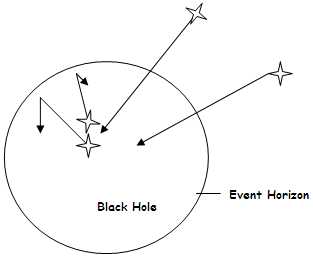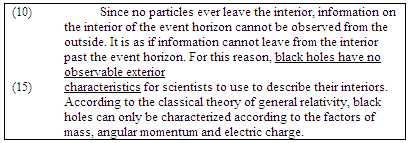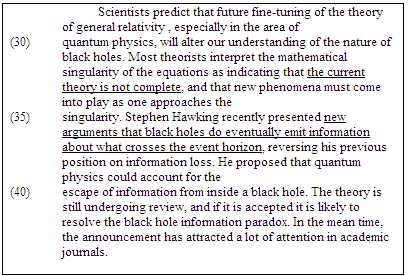LSAT Reading Comp Outlines For Science
Science passages can be intimidating on the LSAT test, especially if you’re not used to reading science jargon. This makes your outlining process even more important than on another type of reading comp passage.
This is the second in a series about LSAT Reading Comp for Science. If you didn’t read the passage in previous article first, you should go to the first article in the series and try it before moving on with this article. The series includes:
- Natural Science Passages in LSAT Reading Comprehension
- LSAT Reading Comp Outlines For Science
- LSAT Science Passage Questions
LSAT Reading Comp Outlines For Science
Using the passage we just saw for our example, we’re going to build our road map. Let’s take a look at the first paragraph.

As is typical of a science passage, this one has a lot of details:
- “…theoretical event horizon…”
- “…photons traveling away from the center of mass…”
- “…the strong gravitational field…”
- “…particles from outside that area…”
These details can seem intimidating because they are so technical. This is especially true for non-science readers. Realize that just as in most other LSAT passages, these details are only there to support the passage. The LSAT is trying to intimidate you and waste your time with these details.
What happens when you read a science passage is you start to dwell on unfamiliar terms, so you read the same line over and over again until you decide it’s over your head. The truth is:
1) some details cannot be deciphered in a science passage and you will never be asked to do so;
2) you’re safe skipping details and rereading them only if you get asked a question about them later.
Want proof? We’ve substituted Flintstones characters for the details we picked out in the first paragraph above. Read the passage with the new “details,” and see if the logic and structure doesn’t get you through the main idea anyway.

Look how much easier it is to understand the passage if you just take the key phrases we underlined above and formed a quick paraphrase:
- “The event horizon limits the interior of the black hole…”
“…particles from outside that area can enter…”
“…but will be incapable of exit.”
It’s pretty clear that this opening paragraph is about one simple idea:
Main idea: The event horizon is like a barrier around a black hole – stuff can get in but nothing gets out.
After reading the first paragraph you might have come up with the following and even taken the time to write something like this down in your test booklet:
Topic: Black Holes
Scope and Purpose: To describe a specific characteristic of black holes, the event horizon.
Main idea: The event horizon is like a barrier around a black hole – stuff can get in but nothing gets out.
You might try a sketch to help you visualize the situation:

LSAT Reading Comp Outline: Second Paragraph
Now that we know what the passage is mainly about:
Main idea: The event horizon is like a barrier around a black hole — stuff can get in but nothing gets out.
Let’s continue on with the second paragraph as we build our outline.

Again we’re faced with a lot of details. But the entire paragraph can be summarized by the one sentence we’ve underlined. If you struggle, you might notice the key words like “Since,” which signals evidence, and “For this reason,” which signals an upcoming conclusion. A paraphrase might be:
We can’t describe black holes from our position on the outside.
LSAT Reading Comp Outline: Third Paragraph
The third paragraph is short and sweet.

I don’t know about you, but anytime someone starts spouting off about space-time I figure I’m either at a Star Trek convention or faced with a really intimidating big brain on the other side of the conversation. This passage is no different — I feel an urge to snooze. But again, even though the paragraph in question is relatively short to start with, you can easily whittle it down further to a few key phrases we’ve underlined. In particular, the word “Thus” tells you that a conclusion is coming, and is probably the main idea.
Here’s what we underlined:
- Center
- Singularity
- Gravity becoming infinitely powerful
- Thus
- All particles
- Move toward it
Like a bad piece of poetry, it’s now entirely obvious and not subtle at all:
Everything in a black hole moves toward the center “singularity”
Fourth Paragraph and Road Map
The fourth and final paragraph throws in a curve ball:

There is a ton of stuff going on here: dense scientific writing, details, and some macro-details about Steven Hawking’s recent thoughts about black holes. Those are all details supporting the simple phrases we underlined above:
- “…the current theory is not complete…”
- “…new arguments that black holes do eventually emit information about what crosses the event horizon…”
Putting it all together into our outline, we get:
P1: The event horizon is like a barrier around a black hole – stuff can get in but nothing gets out.
P2: We can’t describe black holes from our position on the outside.
P3: Everything in a black hole moves toward the center “singularity”
P4: Our theories of black holes are not complete — information might pass back through after all.
Main Idea (refined): We thought the inside of a black hole was indescribable since no information could leave, but that might not be true.
Basically, when it comes to black holes, we don’t know what we don’t know. The structure of the passage seems to be: Here’s some facts we think we know about black holes, but the theory is changing and here’s a contradictory example (Steven Hawking). Simple once you break it down.
Next we’ll look at some typical questions you might be asked for a passage like this in the next article, LSAT Science Passage Questions.
